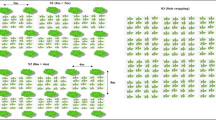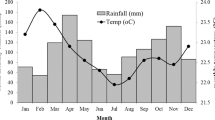Abstract
The increasing demand for biomass for biofuel production is facing challenges due to shortage of feedstock. Growing a variety of different short rotation tree species as well as oil seeds on marginal lands, as an inter crop, may contribute to energy security, climate change mitigation, apart from creating new employment opportunities in a sustainable way. Ailanthus excelsa Roxb. (Mahaneem) is one of the promising fast-growing and multipurpose trees of dry areas and used in various plantation programmes due to its ability to grow well with less rainfall. Therefore, in this study, Ailanthus excelsa based agroforestry systems (growing of trees and food crops simultaneously on the same piece of land) with different plant geometry, i.e. 10 × 20, 10 × 10, 10 × 6.5 and 10 × 5 m (50, 100, 150 and 200 trees ha−1) were assessed for food and biomass production. Among all the plant geometries, the plant geometry of 10 × 20 m exhibited higher yield components and yield viz. number of effective tillers and siliquae per plant (306.7 m−2 and 268.42), number of grains per spike and per siliqua (44.83 and 12.5), test weight (40.21 and 5.89 g), grain and seed yield (3.93 and 1.90 t ha−1), straw and stover yield (5.0 and 2.70 t ha−1); and root weight (2.11 and 0.76 t ha−1) and total biomass (11.04 and 5.36 t ha−1) of wheat and Indian mustard, respectively. Biomass of 28.6 t ha−1 from trees and 5.9 t ha−1 from wheat (only straw and underground) under 5 × 4 m tree geometry can be potential feedstock for biofuel production on sustainable basis.


Similar content being viewed by others
References
Anjaneyulu B, Shanker KS, Kanjilal S, Reddy JRC, Ravinder T, Prasad RBN, Rao BVSK (2017) Physico-chemical characterization and biodiesel preparation from Ailanthus excelsa seed oil. Energy Sources A Recovery Util Environ Eff 39(8):811–816. https://doi.org/10.1080/15567036.2016.1266419
Ansgar Q, Jens W, Christian B, Holger G, Dirk F, Bernd S, Reinhard H (2009) Ecological benefits of the alley cropping agroforestry system in sensitive regions of Europe. Environ Sci Policy 12:1112–1121. https://doi.org/10.1016/j.envsci.2009.08.008
Ashok K, Savita GHS, Shivani D, Shruti S, Priyanka S, Anchal R, Rahul K (2017) Development and release of high yielding clones of Eucalyptus tereticornis SM. Indian for 143(12):1221–1225
Balooni K (2003) Economics of wasteland afforestation in India, a review. New Forest 26:101–136. https://doi.org/10.1023/A:1024494010538
Bayala J, Teklehaimanot Z, Ouédraogo SJ (2002) Millet production under pruned tree crowns in a parkland system in Burkina Faso. Agrofor Syst 54:203–214. https://doi.org/10.1023/A:1016058906682
Blanchet G, Barkaoui K, Bradley M, Dupraz C, Gosme M (2021) Interactions between drought and shade on the productivity of winter pea grown in a 25-year-old walnut-based alley-cropping system. J Agron Crop Sci. https://doi.org/10.1111/jac.12488
Boffa JM, Taonda SJB, Dickey JB, Knudson DM (2000) Field-scale influence of karité (Vitellaria paradoxa) on sorghum production in the Sudan zone of Burkina Faso. Agrofor Syst 49:153–175
Casillas CE, Kammen DM (2010) The energy-poverty- climate nexus. Science 330:1181–1182. https://doi.org/10.1126/science.1197412
CFA (2010) An Overview of the forests and forestry sectors of the countries of the commonwealth, commonwealth forestry association, Shropshire, UK
Dale VH, Kline KL, Wright LL, Perlack RD (2011) Interactions among bioenergy feedstock choices, landscape dynamics, and land use. Ecol Appl 21:1039–1054. https://doi.org/10.1890/09-0501.1
Deswal AK, Nandal DPS (2008) Growth and yield of wheat (Triticum aestivum) under varying levels of irrigation and fertilizer in Eucalyptus based agri silviculture system. Indian J Agrofor 10(1):10–14
Dhyani SK, Newaj R, Sharma AR (2009) Agro-forestry: its relation with agronomy, challenges and opportunities. Indian J Agrofor 54(3):249–266
Evans GC, Bainbridge R, Rackhan O (1976) Light as Ecological Factor. Blackwells, Oxford
Gama-Rodrigues AC (2011) Soil organic matter, nutrient cycling and biological dinitrogen-fixation in agro-forestry systems. Agrofor Syst 81:191193. https://doi.org/10.1007/s10457-011-9372-9
Garrett HE, McGraw RL, Walter WE (2009) Alley cropping practices. In: Garrett HE (ed) North American agroforestry: an integrated science and practice, 2nd edn. American Society of Agronomy, Madison, pp 133–162
Handa AK, Toky OP, Dhyani SK, Chavan SB (2016) Innovative agroforestry for livelihood security in India. World Agric 7:7–16
Holzmueller EJ, Jose S (2012) Bioenergy crops in agroforestry systems: potential for the US North central region. Agrofor Syst 85:305–314. https://doi.org/10.1007/s10457-012-9573-x
Inurreta-Aguirre HD, Lauri PÉ, Dupraz C, Gosme M (2018) Yield components and phenology of durum wheat in a Mediterranean alley-cropping system. Agrofor Syst 92:961–974. https://doi.org/10.1007/s10457-018-0201-2
Jaimini SN, Patel NM, Patel JM, Patel SB (2006) Potential role of Ardu (Ailanthus excelsa) in agro-forestry systems for sustainable rainfed agriculture in Gujarat. Indian J for 29(4):395–397
Jat HS, Singh RK, Mann JS (2011) Ardu (Ailanthus sp.) in arid ecosystem: a compatible species for combating with drought and securing livelihood security of resource poor people. Indian J Tradit Knowl 10(1):102–113
Jha P, Mohapatra KP, Dubey SK (2010) Impact of land use on physico-chemical and hydrological properties of usti fluvent soils in riparian zone of river Yamuna, India. Agrofor Syst 80:437–445. https://doi.org/10.1007/s10457-010-9338-3
Jose S, Gold MA, Garrett HE (2012) The future of agroforestry in the United States. In: Nair PKR, Garrity D (eds) Agroforestry: The future of global land use. Springer, The Netherlands, pp 217–246
Kaushik N, Tikkoo A, Yadav PK, Deswal RPS, Singh S (2017a) Agri-silvi-horti systems for semi-arid regions of North-West India. Agric Res 6(2):150–158. https://doi.org/10.1007/s40003-017-0247-9
Kaushik N, Gaur RK, Mehta K, Kumari S, Yadav PK (2017b) Ailanthus excelsa Roxb.: an agroforestry tree species for arid and semi-arid ecosystems. Indian J Agrofor 19(1):12–23
Ko JK, Lee JH, Jung JH, Lee SM (2020) Recent advances and future directions in plant and yeast engineering to improve lignocellulosic biofuel production. Renew Sustain Energy Rev 134:110390. https://doi.org/10.1016/j.rser.2020.110390
Koh LP, Miettinen J, Liew SC, Ghazoul J, Ehrlich P (2011) Remotely sensed evidence of tropical peatland conversion to oil palm. Proc Natl Acad Sci USA 108:5127–5132
Kumar A, Kumar M, Nandal DPS, Kaushik N (2013) Performance of wheat and mustard under Eucalyptus tereticornis based agrisilviculture system. Range Mgmt and Agrofor 34(2):192–195
Kundu P, Laskar S (2008) Fractionation and some chemical studies on Ailanthus excelsa Roxb seed protein. Am Oil Chem Soc 85:835–843. https://doi.org/10.1007/s11746-008-1273-3
Lamerre J (2017) Above-ground interactions and yield effects in a short rotation alley-cropping agroforestry system. Dissertation, University of Halle-Wittenberg, Germany
Limayem A, Ricke SC (2012) Lignocellulosic biomass for bioethanol production: current perspectives, potential issues and future prospects. Prog Energy Combust Sci 38:449–467. https://doi.org/10.1016/j.pecs.2012.03.002
Mabee WE, Saddler JN (2010) Bioethanol from Lignocellulosics: status and perspectives in Canada. Bioresour Technol 101:4806–4813. https://doi.org/10.1016/j.biortech.2009.10.098
Meena LR, Mann JS, Sharma SC, Mehta RS (2001) Performance of ardu (Ailanthus excelsa) under silvipasture system in semi-arid Area of Rajasthan. Indian J for 7(1):32–35
Meena LR, Sharma SC, Mann JS (2003) Effect of Ardu densities and inter cropping on performance of grass and legume in silvi-pastoral system under semi-arid conditions of Rajasthan. Range Mgmt and Agrofor 24(2):123–126
Morales M, Arvesen A, Cherubini F (2021) integrated process simulation for bioethanol production: effects of varying lignocellulosic feedstocks on technical performance. Bioresour Technol 328:124833. https://doi.org/10.1016/j.biortech.2021.124833
Patel JM, Jamini SN, Patel SB (2008) Evaluation of Neem and Ardu based agri-silvi system. In: Pratap N, Singh MP, Kar A, Kathju S, Kumar P (eds) Diversification of Arid Farming Systems (). Scientific Publisher, India, pp 114–118
Prasad JVNS, Korwar GR, Rao KV, Srinivas K, Srinivasarao CH, Pedababu B, Venkateswarlu B, Rao SN, Kulkarni HD (2011) On-farm evaluation of two fast growing trees for biomass production for industrial use in Andhra Pradesh. Southern India New for 42(1):51–61. https://doi.org/10.1007/s11056-010-9236-6
Puri S, Nair PKR (2004) Agroforestry research for development in India: 25 years of experiences of a national program. Agrofor Syst 61:437–452. https://doi.org/10.1023/B:AGFO.0000029014.66729.e0
Qiao X, Sai L, Chen X, Xue L, Lei J (2020) Impact of fruit-tree shade intensity on the growth, yield, and quality of intercropped wheat. PLoS ONE 14(4):1–17. https://doi.org/10.1371/journal.pone.0203238
R Core Team. (2020). R: A language and environment for statistical computing. R Foundation for Statistical Computing
Rajalingam GV, Manikandan M, Parthiban KT (2017) Performance of green leafy vegetable crops under Ailanthus excelsa based silvi-horticultural system in western zone of Tamil Nadu. Chem Sci Rev Lett 6(24):2159–2162
Ravi R, Divya MP, Krishnan PR (2009) Evaluation of fodder crops under Ailanthus excelsa Roxb. based agro-forestry system. Indian J Agrofor 11(2):90–93
Sahay S, Rana RS (2017) Hemicellulose hydrolysate from Ailanthus excelsa wood potentially to fermentable ethanol. J Trop for Sci 29(2):172–178
Samra JS, Kareemulla K, Marwaha PS, Gena HC (2005) Agroforestry and livelihood promotion by cooperatives. National Research Centre for Agroforestry, India, p 104
Schroth G, Fonseca GAB, Harvey CA, Gascon C, Vasconcelos HL, Izac A-MN (2004) Agroforestry and biodiversity conservation in tropical landscapes. Island Press, Washington, p 523
Seth SK, Raizada MB, Khan WMA (1962) Trees of Vana Mahotsava. F.R.L and Colleges, Dehradun
Shamsudheen M, Dayal D, Meena SL, Ram B (2014) Carbon sequestration in agroforestry and pasture systems in arid north western India. Current Sci 107(8):1290–1293
Sharma KC (2015) Performance of different grain legumes and pasture grasses under agri-silvi-pastoral system in arid tropics of India. Range Manage Agrofor 36(1):41–46
Singh B, Singh G (2015) Biomass production and carbon stock in a silvi-horti based agroforestry system in arid region of Rajasthan. Indian for 141(12):1237–1243
Sosovele H (2010) Policy challenges related to biofuel development in Tanzania/Politische Herausforderungen in Bezug auf Biokraftstoffe in Tansania. Af Spectr 45:117–129. https://doi.org/10.1177/000203971004500105
Surki AA, Nazari M, Fallah S, Iranipour R, Mousavi A (2020) The competitive effect of almond trees on light and nutrients absorption, crop growth rate, and the yield in almond–cereal agroforestry systems in semi-arid regions. Agrofor Syst 94:1111–1122. https://doi.org/10.1007/s10457-019-00469-2
Tadesse S, Gebretsadik W, Muthuri C (2021) Crop productivity and tree growth in intercropped agroforestry systems in semi-arid and sub-humid regions of Ethiopia. Agrofor Syst 95:487–498. https://doi.org/10.1007/s10457-021-00596-9
Van Heerden PDR, Donaldson RA, Watt DA, Singels A (2010) Biomass accumulation in sugarcane: unravelling the factors underpinning reduced growth phenomena. J Expt Bot 61:2877–2887. https://doi.org/10.1093/jxb/erq144
Zhang M, Yu GR, Zhuang J, Gentry R, Fu YL, Sun XM et al (2011) Effects of cloudiness change on net ecosystem exchange, light use efficiency, and water use efficiency in typical ecosystems of China. Agric for Meteorol 151:803–816. https://doi.org/10.1016/j.agrformet.2011.01.011
Author information
Authors and Affiliations
Corresponding author
Additional information
Publisher's Note
Springer Nature remains neutral with regard to jurisdictional claims in published maps and institutional affiliations.
Rights and permissions
Springer Nature or its licensor (e.g. a society or other partner) holds exclusive rights to this article under a publishing agreement with the author(s) or other rightsholder(s); author self-archiving of the accepted manuscript version of this article is solely governed by the terms of such publishing agreement and applicable law.
About this article
Cite this article
Mehta, K., Kaushik, N. Impact of planting geometry on Ailanthus excelsa L. based silvoarable systems for food and biomass production. Agroforest Syst 97, 739–749 (2023). https://doi.org/10.1007/s10457-023-00824-4
Received:
Accepted:
Published:
Issue Date:
DOI: https://doi.org/10.1007/s10457-023-00824-4




